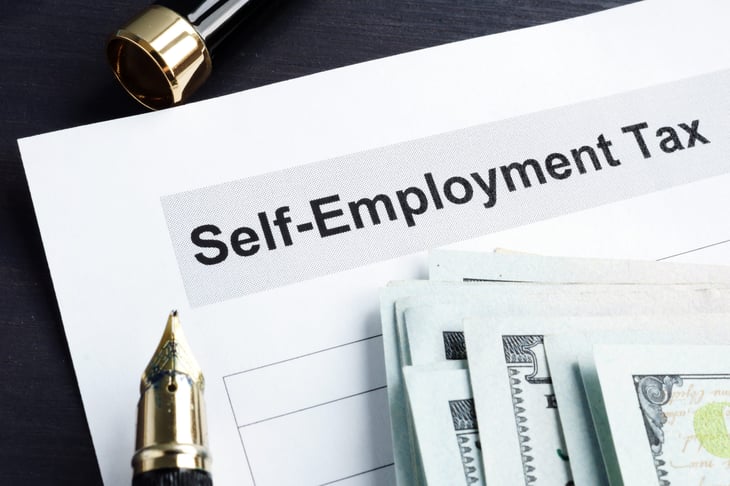
This story originally appeared on SmartAsset.com.
The self-employment (SE) tax is the equivalent of the tax regular employees and their employers pay. It’s the way self-employed people, freelancers and independent contractors contribute to the Social Security and Medicare funds. With a tax rate of 15.3% applying to everything self-employed workers earn, SE tax can add up to a lot. In some cases, SE tax is more than income tax. That means reducing SE tax is an important financial consideration for self-employed taxpayers. Here’s how to do it.
Understanding the SE Tax

The SE tax came into being in 1954 when Congress passed a law that subjected self-employed workers to the same tax requirements as the Federal Insurance Contribution Act (FICA) did in 1935. One difference is that the SE tax is twice as high as the withholding reported on employed workers’ paychecks. This is because self-employed workers are responsible for both halves of the FICA tax, paying 7.65% as the employee as well as another 7.65% as the employer. Breaking it down further, the total SE tax consists of 12.4% for Social Security and 2.9% for Medicare.
Who Is Subject to the SE Tax?

Generally, any self-employed income, including tips, is subject to the SE tax. There are some exceptions, however.
One exception is that income over a certain level, whether from self-employment or wages paid by an employer, is not subject to the 12.4% Social Security portion. The cap on income subject to the Social Security tax generally increases every year. For 2020 it was $137,700 and for 2021 it’s $142,800.
There is no cap to exempt self-employment income over a certain level from the 2.9% Medicare tax. Indeed, since 2013 a provision of the Affordable Care Act levies an additional 0.9% on all incomes over $200,000, including self-employed income.
Another exception is that the SE tax doesn’t apply at all unless self-employment earnings total over $400. And passive income of any amount, such as income from rental real estate, is not considered self-employment income and thus is not subject to the SE tax. Corporate dividends are similarly exempt from the SE tax.
Other than these exclusions, self-employment income is generally subject to the SE tax. It’s not just for people who only have self-employment income either. Full-time employees who have self-income from side gigs have to pay SE taxes on that income if it’s over $400.
How to Reduce SE Taxes

One way to reduce SE taxes is to reduce the amount of taxable net income. SE taxes are generally paid by sole proprietors who file a Schedule C reporting income from their unincorporated businesses along with their personal federal income tax returns. To the extent taxpayers can reduce the amount of income reported on their Schedule C’s, they reduce the amount of taxable income subject to the SE tax.
With this in mind, claiming all allowable business deductions is a can’t-miss way to reduce SE taxes. Allowable business deductions for self-employed people may include home office expenses as well as outlays for advertising, inventory, and other business costs.
After taking all allowable business deductions and reporting that income on their personal tax return, self-employed people can still reduce their taxable income by making contributions to retirement accounts. These accounts can include traditional IRAs, SEP-IRAs, and 401(k) plans.
If the self-employed person is covered by a high-deductible health insurance plan, he or she may be able to contribute money to a health savings account. These contributions also reduce taxable income while allowing the self-employed person to withdraw money, again tax-free, to pay qualified medical expenses.
Change Business Structure

One of the most popular ways to avoid or limit SE taxes is to change the business structure. All the income from a sole proprietorship is likely to be subject to the SE tax because the owner and business are essentially the same entity. Income from a business partnership is also reported on the owners’ personal returns and is subject to SE taxes.
But if the business is incorporated as a regular C corp, S corp, limited liability corporation (LLC), or limited partnership; however, it’s possible to avoid paying SE taxes on at least some income from the business. This is because C corps, S corps, and LLCs are entities separate from the owners. The entities pay taxes on net income at the corporate rate but pay no SE taxes. Similarly, any dividends paid to the owners are not subject to SE taxes.
Corporation owners may have to pay themselves a reasonable salary, which will be subject to regular employment taxes, including both the employee and employer halves of FICA. However, after taking a reasonable salary, owners can choose to distribute any additional earnings of the corporation as dividends on which no SE tax is owed.
Limited partners also can avoid paying SE taxes on distributions from the partnership. However, if they are active in running the business, they run the risk of being categorized as general partners, who are subject to paying SE taxes on self-employment income from the partnership.
Bottom Line

A self-employment tax of 15.3% is generally owed on any self-employment income. Self-employed taxpayers can reduce the amount of SE taxes they pay by taking allowable deductions to reduce business net income. They can also use retirement plan and health savings account contributions to reduce income subject to SE tax. And by creating a separate business entity such as a corporation or LLC, they can have some of the income from the business treated as a distribution that is not subject to SE tax.





Add a Comment
Our Policy: We welcome relevant and respectful comments in order to foster healthy and informative discussions. All other comments may be removed. Comments with links are automatically held for moderation.